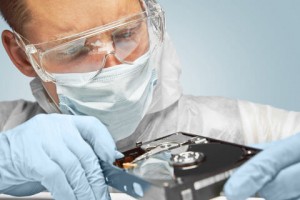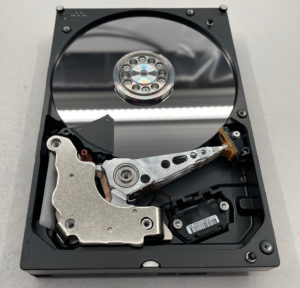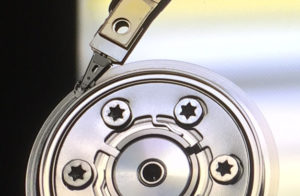 A hard drive’s service area is a hidden, reserved section on the data platters that contains the drive’s firmware (operating instructions). It’s completely inaccessible to the user and to the computer’s operating system.
A hard drive’s service area is a hidden, reserved section on the data platters that contains the drive’s firmware (operating instructions). It’s completely inaccessible to the user and to the computer’s operating system.
The service area impacts how the drive reads, writes, and manages your data. When the service area becomes corrupted, the drive will often fail to initialize, or it might appear as the wrong size or model.
Today, we’ll explain how the service area functions and how it impacts data recovery efforts. If you’re dealing with a hard drive failure, we’re here to help. Datarecovery.com provides risk-free evaluations, and our no data, no charge guarantee ensures that you only pay for successful attempts.
To get started, call 1-800-237-4200 or submit a case online.
What’s Stored in a Hard Drive’s Service Area?
The service area is a collection of dozens of distinct firmware modules, which vary between manufacturers (for example, Seagate drives will have different modules than Western Digital Drives). Even so, they generally contain the same types of information.
Key components stored in the service area include:
- Firmware Code: The core programming that controls the drive’s operations. It manages everything from spinning the platters up to speed to executing read and write commands.
- Defect Lists: No hard drive is perfect. During manufacturing, tiny imperfections are found on the platters. These are recorded in the P-list and G-list; learn more about hard drive defect lists.
- S.M.A.R.T. Data: Self-Monitoring, Analysis, and Reporting Technology logs the drive’s health, tracking metrics like power-on hours, error rates, and temperature.
- Zone Tables: Modern drives write data at different densities across the platters. Zone tables store this information, ensuring the read/write heads are calibrated correctly for each section of the drive.
- Drive-Specific Adaptives: Similar to the data on the PCB’s ROM chip, the service area contains unique calibration data for the internal components, ensuring the heads can read the data tracks reliably.
Drive-specific adaptives are particularly problematic for data recovery laboratories: Without those adaptives, the drive may be unreadable — and since the adaptives are specific to each drive, we need to use special hardware to read and recreate these parts of the service area when a drive is severely damaged.
Hard Drive Service Area Damage: Symptoms
 When a user’s data becomes corrupt, a computer can often still access other parts of the drive. We can clone the drive and deal with the corrupt data by reconstructing the files using specialized software.
When a user’s data becomes corrupt, a computer can often still access other parts of the drive. We can clone the drive and deal with the corrupt data by reconstructing the files using specialized software.
But when the service area is corrupt, the entire drive becomes inaccessible. It no longer has the instructions it needs to operate.
Common symptoms of service area corruption include:
- The drive spins up but is not detected by the computer’s BIOS.
- The drive is detected but shows an incorrect size (as a common example, 0 MB).
- The drive makes clicking or ticking noises as it repeatedly tries and fails to read its own firmware.
- The drive reports an incorrect model name or a generic name. We often see this with firmware bugs in certain drive families.
It’s impossible for a user to fix service area problems. Standard data recovery software cannot work because it relies on the computer’s operating system to communicate with the drive, and a drive with firmware failure cannot communicate correctly.
Related: Before Using Data Recovery Software, Read This
How We Repair Hard Drive Service Area Issues
Repairing the service area is a highly technical process that requires specialized hardware and software tools that can communicate directly with the drive’s firmware. Our recovery process involves these key stages:
- 1. Direct Firmware Access: Our engineers connect the failed drive to a specialized hardware tool that allows them to send low-level commands directly to the drive’s central processor, bypassing the standard data interface.
- 2. Module Diagnosis: We read and analyze the individual firmware modules stored in the service area. Our systems can detect which specific module is corrupt by comparing it against a vast library of known-good firmware from identical drives.
- 3. Virtual Repair or Rebuilding: In many cases, we don’t write directly back to the patient drive’s service area — that’s an unnecessary risk. Instead, we load the known-good firmware module into our system’s RAM and use it to virtually repair the drive. In other cases, we may need to rebuild a corrupted defect list or manually edit a specific module to restore functionality.
- 4. Data Imaging: Once the drive is stable, we immediately create a sector-by-sector image of the user data area onto a healthy drive. The recovery is then performed from this clone, which maintains the integrity of the original media.
Don’t Operate Hard Drives with Firmware Issues

The platters and actuator heads of a hard drive.
If your drive is exhibiting symptoms of a service area failure, power it off immediately. Repeatedly power-cycling the drive while it’s in a compromised state can lead to physical damage, such as a head crash, which makes recovery much more difficult.
Do not install data recovery software or attempt any DIY fixes, as these actions cannot address the underlying firmware issue and may cause further logical damage.
Service area corruption is a complex failure scenario, but it’s also quite common. At Datarecovery.com, our engineers have decades of experience and purpose-built systems designed to overcome these issues. We offer a risk-free evaluation to diagnose the problem, and our no data, no charge policy ensures you won’t pay a fee unless we successfully recover your files.
If your hard drive is no longer recognized, we’re ready to help. Contact our experts at 1-800-237-4200 for a free consultation or submit a case online.




